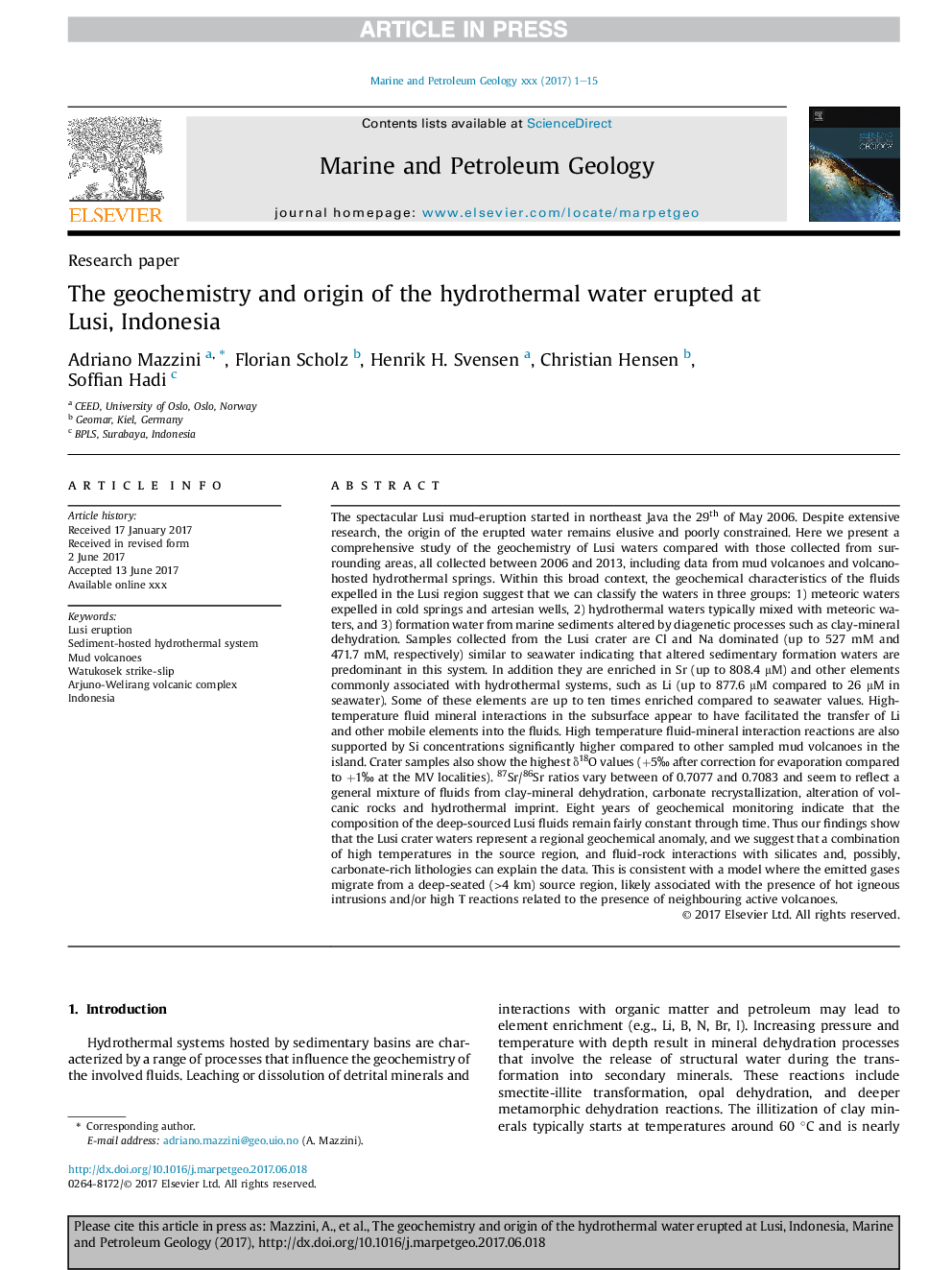| کد مقاله | کد نشریه | سال انتشار | مقاله انگلیسی | نسخه تمام متن |
|---|---|---|---|---|
| 8909227 | 1637135 | 2018 | 15 صفحه PDF | دانلود رایگان |
عنوان انگلیسی مقاله ISI
The geochemistry and origin of the hydrothermal water erupted at Lusi, Indonesia
دانلود مقاله + سفارش ترجمه
دانلود مقاله ISI انگلیسی
رایگان برای ایرانیان
کلمات کلیدی
موضوعات مرتبط
مهندسی و علوم پایه
علوم زمین و سیارات
زمین شناسی اقتصادی
پیش نمایش صفحه اول مقاله

چکیده انگلیسی
The spectacular Lusi mud-eruption started in northeast Java the 29th of May 2006. Despite extensive research, the origin of the erupted water remains elusive and poorly constrained. Here we present a comprehensive study of the geochemistry of Lusi waters compared with those collected from surrounding areas, all collected between 2006 and 2013, including data from mud volcanoes and volcano-hosted hydrothermal springs. Within this broad context, the geochemical characteristics of the fluids expelled in the Lusi region suggest that we can classify the waters in three groups: 1) meteoric waters expelled in cold springs and artesian wells, 2) hydrothermal waters typically mixed with meteoric waters, and 3) formation water from marine sediments altered by diagenetic processes such as clay-mineral dehydration. Samples collected from the Lusi crater are Cl and Na dominated (up to 527 mM and 471.7 mM, respectively) similar to seawater indicating that altered sedimentary formation waters are predominant in this system. In addition they are enriched in Sr (up to 808.4 μM) and other elements commonly associated with hydrothermal systems, such as Li (up to 877.6 μM compared to 26 μM in seawater). Some of these elements are up to ten times enriched compared to seawater values. High-temperature fluid mineral interactions in the subsurface appear to have facilitated the transfer of Li and other mobile elements into the fluids. High temperature fluid-mineral interaction reactions are also supported by Si concentrations significantly higher compared to other sampled mud volcanoes in the island. Crater samples also show the highest δ18O values (+5Ⱐafter correction for evaporation compared to +1Ⱐat the MV localities). 87Sr/86Sr ratios vary between of 0.7077 and 0.7083 and seem to reflect a general mixture of fluids from clay-mineral dehydration, carbonate recrystallization, alteration of volcanic rocks and hydrothermal imprint. Eight years of geochemical monitoring indicate that the composition of the deep-sourced Lusi fluids remain fairly constant through time. Thus our findings show that the Lusi crater waters represent a regional geochemical anomaly, and we suggest that a combination of high temperatures in the source region, and fluid-rock interactions with silicates and, possibly, carbonate-rich lithologies can explain the data. This is consistent with a model where the emitted gases migrate from a deep-seated (>4 km) source region, likely associated with the presence of hot igneous intrusions and/or high T reactions related to the presence of neighbouring active volcanoes.
ناشر
Database: Elsevier - ScienceDirect (ساینس دایرکت)
Journal: Marine and Petroleum Geology - Volume 90, February 2018, Pages 52-66
Journal: Marine and Petroleum Geology - Volume 90, February 2018, Pages 52-66
نویسندگان
Adriano Mazzini, Florian Scholz, Henrik H. Svensen, Christian Hensen, Soffian Hadi,